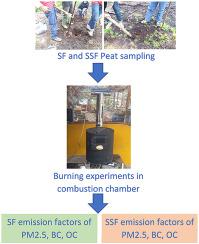Atmospheric Pollution Research ( IF 3.9 ) Pub Date : 2020-06-06 , DOI: 10.1016/j.apr.2020.06.001 Puji Lestari , Fathi Muthmainnah , Didin Agustian Permadi

|
Indonesia has been experiencing an annually reoccurring forest fire events over the peatlands in eastern Sumatera and western Kalimantan and the impacts on the air pollution episodes in the surrounding countries gained international concerns. The most notable events were in 1997 and 2015 which caused significant losses both on human health and economy in the region. Fires in peat layers could spread radially due to peat structure and emitted substantial amount of aerosols containing carbonaceous compounds, including BC/EC and OC. In this study, peat samples from different levels of depth were collected from western part of Kalimantan and were burned in a combustion chamber received from Kyoto University. Particulate (PM2.5) samples from burning experiments were collected and the carbonaceous components (i.e. BC/EC and OC) were also analyzed, respectively. The results showed that average concentration of PM2.5 emitted from the combustion of the surface peat (SF) samples was 7,467 ± 3,976 μg/m³. while the corresponding value for the subsurface (SSF) was 5,693 ± 2,137 μg/m³. In average, EC and OC compositions were 1.9% and 70% to the total of PM2.5 concentrations, respectively. Emission factors (EFs, in g/kg) were estimated for PM2.5, EC, and OC for SF samples of 4.51 ± 0.42, 0.21 ± 0.17, and 3.77 ± 0.82, respectively. The associated EFs for SSF samples were 4.53 ± 1.67, 0.1 ± 0.09, and 1.82 ± 0.43 g/kg, respectively. The results may substantially contribute to fill in the gaps of the availability of EFs for both SF and SFF peat fires in the country to improve the existing PM emission database.
中文翻译:

印尼地表和次表层泥炭燃烧排放的碳质化合物的特征
印尼每年在苏门答腊岛东部和加里曼丹西部的泥炭地上每年都发生着森林火灾,而周围国家对空气污染事件的影响引起了国际关注。最值得注意的事件是1997年和2015年,给该地区的人类健康和经济造成了重大损失。由于泥炭的结构,泥炭层中的火灾可能会径向蔓延,并散发出大量含碳化合物(包括BC / EC和OC)的气溶胶。在这项研究中,从加里曼丹西部地区收集了不同深度的泥炭样品,并在京都大学提供的燃烧室中燃烧。微粒(PM 2.5)收集了燃烧实验的样品,并分别分析了碳质成分(即BC / EC和OC)。结果表明,表面泥炭(SF)燃烧产生的PM 2.5的平均浓度为7,467±3,976μg/m³ 。而对应的地下(SSF)值为5,693±2,137μg/m³。平均而言,EC和OC成分分别占总PM 2.5浓度的1.9%和70%。估计PM 2.5的排放因子(EF,以克/千克为单位),EC和OC对于SF样本分别为4.51±0.42、0.21±0.17和3.77±0.82。SSF样品的相关EF分别为4.53±1.67、0.1±0.09和1.82±0.43 g / kg。结果可能在很大程度上弥补了该国SF和SFF泥炭火灾的EF可用性的不足,以改善现有的PM排放数据库。











































 京公网安备 11010802027423号
京公网安备 11010802027423号